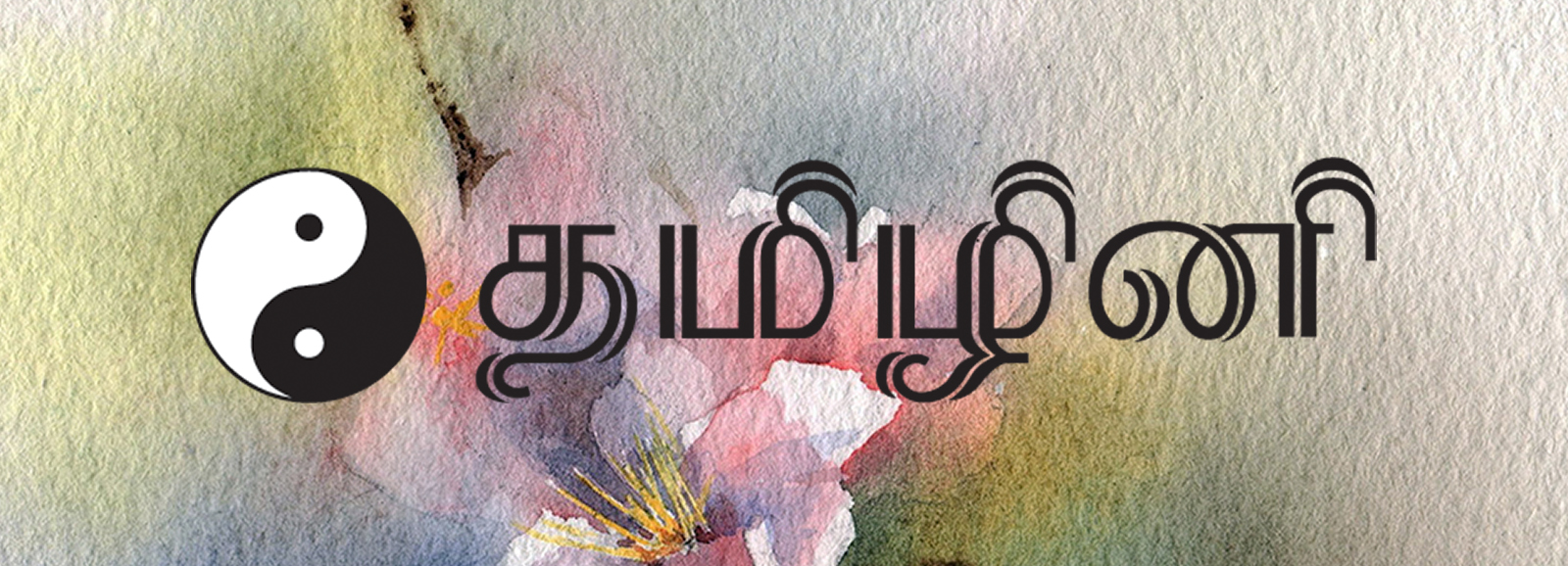‘Taking a new step, uttering a new word, is what people fear most.’ – Fyodor Dostoyevsky in Crime and Punishment.
The significance of investigative journalism attracts a wide audience, especially after the compilations of Svetlana Alexievich, a Belarusian investigative journalist and oral historian, won a Nobel Prize in Literature. Her compilations brought some of the untold personal voices of trauma and suffering out to the world, which in previous times of history might have left unnoticed only to get washed away by the forward arrow of time. This kind of literature, in a way, brings much sophisticated scopes for visual documentation.
The two movies ‘The Act of Killing (2012)’ along with, ‘Look of Silence (2014)’ together come with some groundbreaking ideas of showing some of the intense darkness that happened in recent history. The mass imprisonment that later turned into mass extermination of Communists of Indonesia in 1965 left many scars on the wounded side. But the power gained by the thuggish administration, still finds ways to put a shroudish logics over those scars, and silently carries its business of governing and enjoying some statuses, as if nothing happened. Both of these films were nominated in stages of Academy in best documentary feature.

Joshua Oppenheimer
Recently I was watching the Serbian Masterpiece, ‘Man is not a Bird,’ and came across some jaw dropping moments. The film beautifully merges elements of documentary nature with a strange fictional narrative, resulting in some astounding hypnotic moments, to chew for some time. The director of Indonesian documentaries in focus, Joshua Oppenheimer, was influenced by the Serbian auteur Dušan Makavejev, I gather from online. In contrast to his mentor he cares only at political preferences at national and personal levels.
The lamentations of victims from the mass murders of 1965 in Indonesia, never would have reached the ears of the global community, if it did not come via the strongest visual form, two of documentary films directed by Joshua Oppenheimer. His attempt is bold, and the material is raw. The eyes of history were simply gawking at this massacre as if it is not a thing to ask many questions before this film. We came across similar things all over history, like not just delayed history, but delay in admission of history. Bukarin was termed as innocent after thirty years of his demise, by the statement of Siberian served wife Anna.
2
Some of the executors of the 1965 massacre readily made themselves available in front of the camera to re-enact the killings and the intimidation performed by themselves for making a movie – to a degree of astonishment – willingly. Anwar Congo, who enters into his later old age along with his close acquaintance Herman Koto seemingly, the Protagonist and sidekick respectively for this feature.
They are presenting themselves in a cool manner with the statements like, ‘I was just wearing jeans while killing,’ ‘I forgot to bring machete, it might add authenticity to the acting.’ And they are not at all hesitant to use dummy dolls as children murdered and fake blood to shoot some nightmarish surreal sequences too.
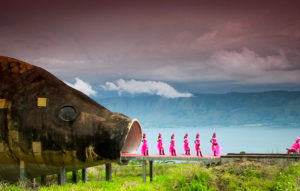
There has been some complex warring business going on around the world after the end of World War II, among which the mass imprisonment and mass expulsions are being the characteristics of tussle between the nation and its citizens identified as some out group. It could happen between two religious groups or between religious fervor in one hand and ideological groups in another. The most horrifying thing that came into mind is the turn of democracy towards the right wing political agenda around the world one by one, look for bigger nations like Russia, Germany, United States and even India. The film becomes much relevant to the current status of international politics and makes heart a dreadful beating drum.
Homo sapiens have the untiring tendency to hate people of out-group, especially of its own species possible explainable in two components. The emotional imaginary bond they share with their own in-group beliefs, resulting in complete moral acceptance of brutal killing of anybody who doesn’t seem to side with their group. This is the component Uno. The second and most important part of hatred towards their destined enemy might occur due to the brainwashing towards the image of that enemy, which would pave the way for murdering them without guilt conscience, especially when the state sponsors for it.
The second component is well documented and observed in these documentaries, which analyze the inside peek of cerebrum of the persons responsible for the massacre against the Communists of Indonesia during 1965 with an unbiased view of the executors filling the running hours of the film.
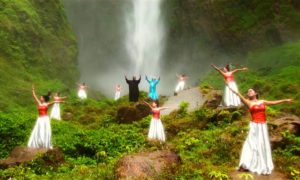
The powerfulness of the visual medium with the aim of documenting a darker camp of history came out with a new degree of authenticity. The honest approach of storytelling in a fresh light garnered the movies worldwide observant and praising eyes. The Act of Killing was nominated in the Stage of Academy Awards but only for losing to some other, still the acclaim got international interest on the story as well as the painful misdeeds and mishaps came as a huge shock for any of its audience. The director Joshua Oppenheimer should be praised for the uncompromising attempt and completion which I would reckon as sheer brilliance.
The Pancasila youth, is the paramilitary organization, comprising about 3 million members, which had a prominent role in killing the communists during 1965. The leaders of those organization as well as political higher ups are well equipped with their ready-made horrifying comments to argue with. One of the leaders puts it like something this: “we have too much democracy; it is chaos; under dictatorship there is economy and security.”
The Pancasila youth have much to confess if they are rightly interviewed, which doesn’t going to happen in nearby times. Hence, the movement comes as a cameo for this film. Some of the re-enactment of killing has been taking place before camera, by putting fire over the huts, which kindles the unconscious spirit of the participant extras, to cry uncontrollably. And some of the political meetings, where openly a national political higher up supports even show jingoism towards the backing up of thugs. At least more than once, the many people from this film mentions about the origin of the word ‘gangster’, which literally means ‘free man’, if not with any shame, with pristine confidence.
It is comprehensible that any movie is being made, with its intention of making the mass to believe the story told. In The Act of Killing a mention of a movie that was shot just before the massacre, contained a planned propaganda to create the image of any communist to be looked as some kind of devil or misdoers in any sense by the mass of the country. Later it might be used as a tool for the convincing of the public that the killing of communists anyhow is right. It blocks the tendency of people to empathize with the suffering of so colored communists.
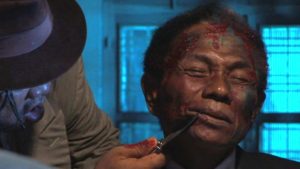
In one of the scenes the killers were portraying the interrogation done to one communist along with their execution method. It seems that the murder was carried out with plain hate and intention to show the level of dominance one human can exert on another. After re enacting the killing scene one of the killer, now transformed as a businessman, mentions, ‘if the scene becomes a success, it would show us in bad light to the people who might watch the film, and they would feel bad about the killing of communists and the lies we constructed before them. And I am sure, that that was correct in a sense, too.’
The killers are mentioning some of the Hollywood actors like Al Pacino, John Wayne and Sidney Poiter; they were proving a point about their old day’s interest of enjoying the American films. Anwar Congo was once a ticket seller from black market recalls the harsh act of communist to come with a ban on American films. Another local newspaper man admits he had to deliberately add or cut out something from an interview given by any comrade, so that ensuring never a good light would fall on Communists. He further adds while asked to go elaborate on the moments of killing, he just plainly says he never went to kill by his hand, and it would not be necessary, just a wink from him would do.
Various ministerial officers were interrogated for this film invariably all of them seem to be in close acquaintance, for instance, Jusuf Kalla, the Vice President of Indonesia. This triangular consolidation of thugs, military and the Government made possible the sheathing of grief and bloodshed of this magnanimity.
In final moments of the film gradually uncovers the haunting memories and the Ghostly nightmares experienced by Anwar Congo, which also get its part in the production design of the intended gangster movie.
3
Killing each other in warfare would seem better than murdering lakhs of defenseless enemies, under the imaginary banners of Religion and Nationality. In 1965, all of sudden, when the Indonesian Government was overthrown by a military demonstration, under that dictatorship over millions of military enemies were murdered in brutal as well as using peaceful methods. The movie, Act of Killing enters into the world of so called heroes of death squads as they are happily sharing their memories of methods and jubilation over those killings. The Second movie Look of Silence (2014), takes the point of view of one of the victims to share a much harder and finer story like wearing a Crown of, and walking in a path of Throne.
Though the Look of Silence never shows any ruptured veins or flaming huts even in graphic animated sequences, the eeriness it creates was much abundant than its predecessor. It just changes the Point of View from the executors to one of the family member of the victim, and the resultant proximity of audiences to empathy becomes several fold.
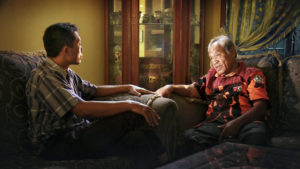
This astounding initiation – shaking a leg with open eyes as well as hands – from the side of victim towards the murderers is what the hardest form of seeking truth, nothing easier in every angle. But still Adi Rukin, a brother of murdered, named Ramiln enters homes of the every fatherly and grandfatherly aged neighbors, with a plan of diagnosing and treating their eye status.
Some of the interviewee blames the openness to question about the intricate details of murders that happened during 1965, but others were keen on giving details. But it looks overall, none of them are feeling guilty or admitting their act of hate with shyness. The poor interviewer goes for frustration due to the fact of nobody those involved with the murder of his brother is going to hug him for good. They still believe that everything happened, because it should happen. Sometimes they defend their actions saying it was in the interest of the nation, or the murdered were the real evil, then to be destroyed.
One of the old Muslim men says that Islam never advocates killing, and their prophet never killed anybody. But still he defends himself with the notion that enemies should be killed, so he murdered. The controversial statements made him angry and he blames Adi for asking too deep questions. Further during the interview he states: ‘Drinking your victims’ blood is must; otherwise you would go crazy and I knew some of the people who went crazy on that idea.’
In another scene, the pupils of the nation were taught the communists were some partners of the devil. They might grow thinking the communists as eternal enemies.
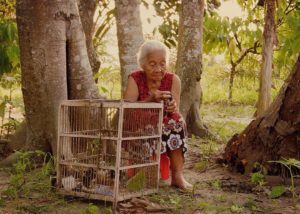
The hardest part of all comes later. Adi goes to the house of the exact killer of his brother, Ramlin, which is evident from the footage previously taken. But the killer was dead as of now, presumably due to old age. Now Adi meets with the sons and wife of the killer, which creates a smell of tension in the atmosphere. Even after the explanation of Adi for his thirst on truth without any feeling or revenge from his side, the sons are not so welcoming on their part. After accepting suffering, he moves out with a weighing heart.
Both senile fathers with mother keeping him well, Adi shares this side of truth. The father never would capture the truth, as he is thinking that he is just 16 years old, according to his mental comprehension. But the mother gets everything Adi explains and longs for the judgment from the Almighty, if there is one.
The correction of lenses for the geriatrics develops as a metaphoric theme for the movie itself. Sometimes none of the focal length suits for them to see the field clearly, or they are hesitating to wear some eye for seeing truth. Unlike the previous film, The Look of Silence (2014), the approach of the director is going similar to the much respected ‘Shoah,’ directed by Claude Lanzmann. It does not dramatize anything, but goes on with a pace of natural statements, leaving the audiences haunting.
